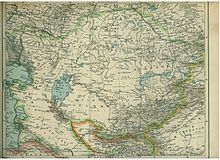Naimans
The Naiman (/ˈnaɪmən/; Mongolian: ᠨᠠᠶᠢᠮᠠᠨ [ˈnɛːmɴ̩]; Kazakh and Kyrgyz: Найман, نايمان [nɑjˈmɑn]), meaning The Eight, were a medieval tribe originating in the territory of modern Western Mongolia[9] (possibly during the time of the Uyghur Khaganate),[10] and are one of the 92 tribes of Uzbeks, modern Mongols[2] and in the middle juz of the Kazakhs.
[12] In the Russian and Soviet historiography of Central Asia they were traditionally ranked among the Mongol-speaking tribes.
[13] For instance, such Russian orientalists as Vasily Bartold,[9] Grigory Potanin, Boris Vladimirtsov, Ilya Petrushevsky, Nicholas Poppe,[13] Lev Gumilyov,[14] Vadim Trepavlov classified them as one of Mongol tribes.
[15][16][17][18] However, the term "Naiman" has Mongolian origin meaning "eight", but their titles are Turkic, and they are thought by some to be possibly Mongolized Turks.
After the collapse of the Yuan dynasty, the Naiman were eventually assimilated into Mongol, Tatar, and Kazakh tribes.
[22] According to Lee & Kuang, the Naiman and the Önggüt tribes were descending from the remainders of Turkic peoples of Central and Eastern Mongolia, which stood not in contact with Iranian groups West of the Altai Mountains, unlike "Western Turks".
[29] The commander of the Mongol army that invaded Syria in 1259, Kitbuqa, was a Naiman: he is recorded to have "loved and honoured the Christians, because he was of the lineage of the Three Kings of Orient who came to Bethlehem to adore the nativity of Our Lord".
[30] However, Kitbuqa was slain and his army decisively defeated at the Battle of Ain Jalut, ensuring continued Muslim hegemony over the Levant.
[22] The Naimans who settled in the western khanates of the Mongol Empire all eventually converted to Islam.

